
13 minute read
FLORIDA REAL ESTATE REVIEW
As you idle in trafc one Saturday morning somewhere on I-4 in the suburbs of Orlando or Tampa you might wonder to yourself: “When did there get to be so many people around here?”
While that might be a pertinent question in 2021, it could just have easily been asked by Orange and Pinellas county residents in 1961, sitting in their Buick Roadmasters or Cadillac Coup de Villes after populations there more than doubled during the previous decade. One can only imagine the complaints that must have been uttered by Levy and Suwannee county buggy operators as the 1870s brought twice as much trafc there. Florida’s history has always been marked by explosive growth. As Tracy Lawrence sang: “Everything stays the same, everything changes, everything changes.”
Advertisement
The combination of increased population growth, depleted inventory, home construction defcit, low mortgage interest rate environment, expansion of remote work, and surging Baby Boomer retirements points to continued strength in the Florida, and especially the I-4 corridor’s real estate market for the foreseeable future.
In each census since 1850 Florida’s relative growth has outpaced that of the United States. Over the last fve decades Florida’s net population uptick alone has provided as much as 14.4% and no less than 9.3% of the entire country’s increase. With the third-largest state population in the United States (21.5million), Florida’s 14.6% growth over the last ten years was actually its lowest of all time. And it doesn’t just originate internally, around 4.5million Florida residents were foreign born, more than 21% of the population.
Looking more closely at Farm Credit of Central Florida’s region, those thirteen counties have experienced growth at a faster rate than the state consistently since the 1950s, and that is forecast to continue through 2040. Though the rate of increase has tapered, millions of additional drivers on the road have surely increased trafc as they work and play throughout the state. And, at the end of the day, they need a place to sleep at night.
Florida’s population growth and need for housing does not stem from a singular source. Its probusiness economic policies have been a driving factor attracting companies from other states and across the globe. Tourism has been a major revenue stream for the state even before Walt Disney introduced the world to his mouse, especially after Henry Flagler shortened the travel time for Northerners with his railroad down the Atlantic coast. While the Sunshine State’s warm weather has been attracting retirees for decades, the 1950s-era advent of popularized air-conditioning made it a destination for those who prior couldn’t quite take the heat.
So What Does
Florida has been a lower-cost state for decades compared with many Northern (and some Southern) counterparts, with the lack of a state income tax strongly supporting its attractiveness. According to Redfn, a national real estate brokerage, a national real estate brokerage, the median home sale price in the state was only 71% of the national average as recently as 2012, but in January 2021 Florida caught up to 93%, and that ratio is trending upon convergence. The rate at which Florida’s home prices are jumping to meet US Census Bureau median sale values is even quicker.
While these developments have been ongoing for years, the coronavirus pandemic’s impact on housing and Florida’s reaction to the crisis set it apart. Florida has been fully open by executive order since March, but it was a national leader in September 2020 when it allowed restaurants to operate at 100% capacity. Nearly nine months later, some states still have not fully reopened bars and restaurants, such as California, Colorado, Illinois, and Pennsylvania. So while Florida has been a desirable place to live, for those wishing to participate in a more open economy and social setting it became one of the only places that allowed that. Further, the newly widespread practice of work-from-home has given millions of Americans the fexibility to migrate. This happened around the country, spurring a roaring housing market as families sought amenities like pools and yards for their kids, and many which had held out on home-buying decided to fnally “pull-the-trigger.”
The US housing inventory, according to the Realtor.com residential listings database, dropped 52% year-on-year from March 2020 to March 2021.

Florida, however, drastically outpaced even that, with its total listings dropping 64% from March 2020 to April 2021.
In order to understand the Florida market a little better let’s take a look at some metrics. One characteristic that has bolstered demand for Florida homes is that they have remained (by median sales statewide) lower-priced than the national average. The spread between national values and those in the Sunshine state continues to narrow over the long-term, but during the pandemic it has remained fairly stable (a 23% increase yearon-year nationally versus 21% in Florida according to Redfn, a national real estate brokerage). What can be seen on the chart above is that median national sales and median Florida sales were trending closer through January 2021 before widening (however marginally) over the last two months. At the same time, Florida’s total listings have declined at a more rapid rate than the US as a whole, with there actually being an uptick in listings for April.
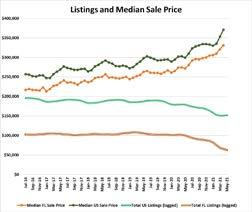
IF PRICES HAVE BEEN RISING CONSISTENTLY FOR THIS LONG, HOW MANY HOMES ARE ON THE MARKET?
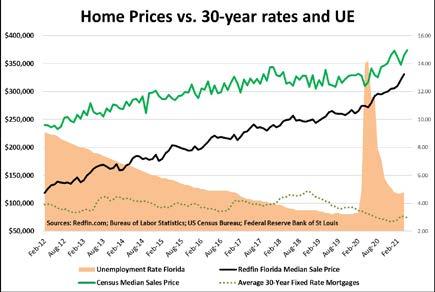
The answer is “not very many.” From a high of over 164,000 homes on the market in February 2019 the number in May 2021 was down to 50,561, a decline 69% (according to Realtor.com residential listings database). Across the country the total number of listings has been declining since the start of the pandemic, but at a much slower rate. As a matter of fact, new listings were added to the market nationwide in May after remaining fairly fat from March-April but continued steep declines in Florida.
larger loans. Additionally, Florida’s median prices continue to increase smoothly, with less volatility than the national median, underlying steady (but also marginally increasing) demand (the national numbers are more likely to be skewed from sample error and monthly revisions).
One unique facet of the recent housing boom has been peak in November 2018, encouraging borrowers to take on that unemployment has not appeared to have a noticeable impact. Across the nation and especially in Florida home prices actually rose at a faster pace after the major layoff in March 2020. This tracks with surveys indicating that the majority of people moving are higher-income and/or can work from home. Further, average interest rates across the country have dropped as much as 45% from their recent
This leads to the question...

While fewer homes are available in Florida, the ones that are remain on the market somewhat longer (on average) than the rest of the country: 49 days in May versus 39 days nationwide. Fast growing counties, howerver, are on their own schedule, with median days on market for Polk county down to forty-three.
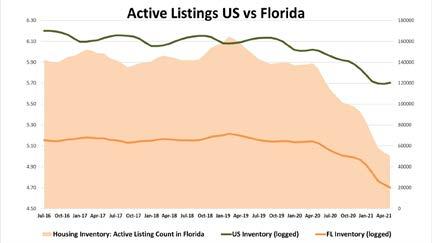

From February-March there were slightly more homes than usual placed on the market in Florida, but not relative to the rest of the country. Further, there is a seasonal aspect to the markets, where new listings across the country decline at the end of summer, and pick-up again early in the fall. Normally, however, there is an inverse relationship between the two, with the rest of the country adding new listings into late-spring, while Florida plateaus and slowly drops. Over the pandemic, however, Florida’s decrease was more moderate than usual and its new listings have remained consistent, marginally increasing by month.
The best indicator we have for what is in the pipeline for Florida is the “New Permits” metric, but not all of these are actually started. Nationwide the total number of new homes with construction actually begun has been increasing very slowly over the past nine years, as builders were apprehensive following the crisis in 2008. Additionally, after the major delay in March 2020, there were further declines in new building starts in both February 2021 and April 2021, contributing to the slack.
We can see that supply is struggling mightily across the state to keep up with demand. Inventory across the state continues to plunge lower, after remaining fat for almost four years leading up to the pandemic. New permits continue to increase, while new listings are on a downward trajectory.
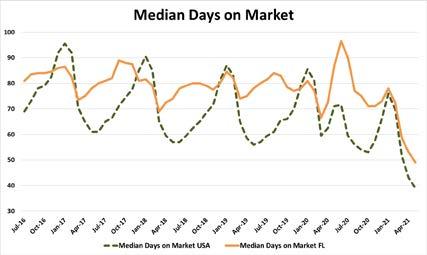
How many of the permits are individuals building their own home is difcult to quantify, but judging from the precipitous declines in inventory we can infer it is not enough. The total months of supply reported by the Florida Realtors Association is down from 3.4 in January 2020 to 1.6 in January 2021. As other indicators of the housing shortage have been exacerbated over the course of the year, it is likely that total months of supply for May 2021 has reached historic lows.
Not only is the home inventory shrinking every month in Florida and fewer homes are being listed, the number of days before being sold has been reduced as well.
Historically, over the winter months (January through March) homes were taken of the market at the same speed as the rest of the country, with a slowdown (moderately inverted relationship) over the summer. What changed during the frst few months of the pandemic was that summer home sales in Florida tracked in-line with the rest of the nation, fying of the market more rapidly. There was no summer inversion for 2020 and as we enter the warmer months of 2021 homes continue to sell at the fastest pace on record in Florida and nationally. These three metrics are interrelated.
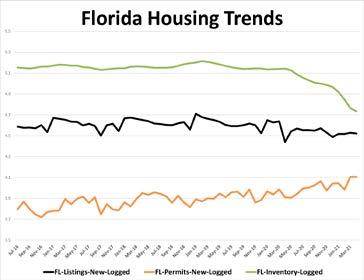
As backlogs in construction build fewer new homes are listed. Individuals without a place to go are uninterested in listing their homes at market highs, meaning less are added to the market. As supply shrinks (and demand expands or remains the same), the properties on the market are snapped up more and more quickly.
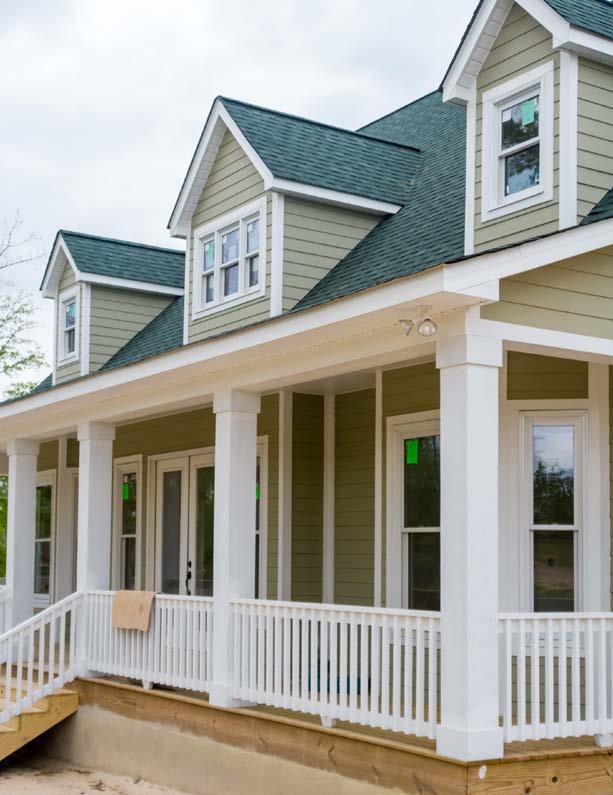
It remains a seller’s market, and without demand dropping, supply drastically increasing, or both, it will remain that way for the foreseeable future. v

Of the thirteen counties in Farm Credit of Central Florida’s territory, Redfin, a national real estate brokerage, has publicly available data on ten of them going back to 2012 (the exclusions being Brevard, Citrus, and Hernando). While the chart is relatively busy, what we can observe is a clear trend of rising prices across the region. Though remaining below the national average, sale values have all climbed steeply at a similar rate. Polk county, reported by the Census Bureau as one of the fastest growing parts of the country, remains consistently the lowest-priced. This cost-competitiveness, along with Florida’s weather, cost-of-living, tax structure, etc. continues to drive its attraction for transplants. Even homes in the most expensive county in the area, Orange, are noticeably below national median prices.
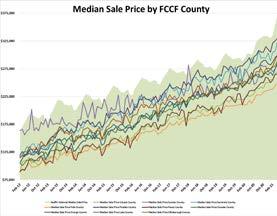

Digging deeper into the numbers by county, however, there is one anomaly in the Central Florida territory: Sumter. Sumter is a diverse county, with multiple small towns like Bushnell and Webster, but also home to a unique American community, the retirement destination called The Villages. One of the fastest growing places in
It is safe to say that 2021 has been a tough year for everyday the country and the Central Florida territory dropped, but the nation, The Villages has not been constrained by typical economic pressures as Americans, and especially in Florida, to buy a home. So for quickly recovered. Since the beginning of 2021 rents in Florida its residents are overwhelmingly fnancially independent. One clear element from those who cannot aford the price increases or do not have have increased at a faster pace than the rest of the country, the chart above is that the volatility in home prices for the community (relevant to cash to beat-out other bidders, renting is the only option to reinforcing the notion of strong housing demand. the rest of the country) is much greater. Thus, while prices stay in the state. Compared with the nation as a whole, Florida have marginally increased over the past nine years on the has a high-price rental environment. Many individuals that whole, they have done so erratically, related to the ebb cannot aford (and may never be able) to buy still seek to live in and fow of retiree sentiment, a vacuum compared with the state because ofts desirability. the rest of the country. While many are moving to the Sunshine state, over the course of the pandemic Sumter’s Additionally, seasonal migration due to weather as well as a housing price relative to the nation has actually declined. dominant tourism industry further the expansion of temporary This has also been the case for the last few months in other living accommodations. Across the the Central Florida counties, including Polk and Orange. Though impossible territory there is a wide range of prices, from an average of to confrm, considering that the length of time on-the- $1,124/month in Volusia for April to $1,401/month in Orange. market for Florida is declining at a slower rate than the rest of the country, prices are not rising as fast, and
Over the last four years, Orange and Osceola have experienced fewer homes are coming on the market, it is possible that the least drastic price increases, but were already the highest many of the properties still listed are subpar and/or in less cost in the region. Polk, on the other hand, has experienced desirable regions. a 22% jump in rent, compared with a 9% hike nationwide and 14% in the state. At the onset of the pandemic rents across

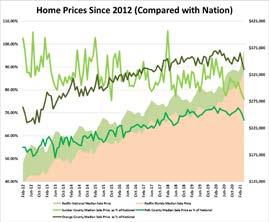
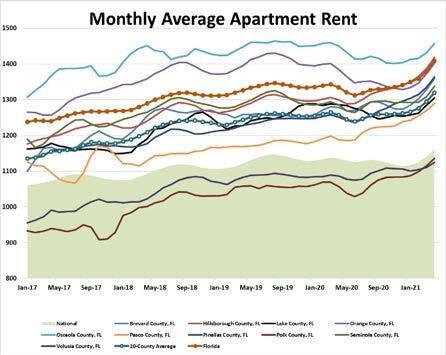
Homeownership rates across the country rose to the highest point since 2008 during summer 2020, before dropping almost to pre-pandemic levels. Rental vacancies, on the other hand, performed in opposite fashion. The homebuilding sector has lagged behind demand, meaning proportionately fewer new rentals coming on the market. With the percentage of homeowners decreasing lately one might expect there to be fewer rental vacancies on the market, but the opposite has occurred: the US is experiencing both a decline in homeownership and a rise in rental vacancies.
This situation may be easily explained, however. Total rental vacancies have been increasing but still not quite reached pre-pandemic levels, a recovery trend after dipping to the smallest percentage of available units on record. We can see that rentals across the country were snapped-up when work-from-home began last spring, some of those could have been second living spaces for those holding a mortgage or another lease (we do not have data points to track this).
Regarding the decline in homeownership rates, two factors are likely largely to blame: increases in multigenerational living and institutional investment in single-family homes. According to the National Association of Realtors, compared with the prior year, the summer of 2020 saw the percentage of multigenerational homebuyers rising from 11% to 15%. While there is some overlap with the ownership rate for those with multiple family members on the deed, what is clear is a signifcant increase in adult families living together. Whether individuals sold their home or let a lease expire and moved in with a child or parent is impossible to know for sure, but its likelihood is strong.
The other factor driving the divergence of rental vacancies from home ownership continues to be an increase in institutional investing.
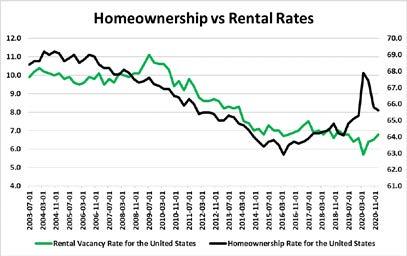
According to Redfn, a national real estate brokerage, institutional or business speculators acquired 15% of the homes purchased in the frst quarter of 2021. This is up from around 8% after the global fnancial crisis, but marginally below the peak of 16% at the beginning of 2020.
Prior to the pandemic investment groups had been increasing their market share, but as the housing shortage is exacerbated their deeper pockets are becoming more noticeable, especially as families are outbid for starter homes. Institutional investors are responsible for more than 20% of low-price home sales, most of which are intended for rental income rather than resale. With the unparalleled disruption caused by the pandemic, it should not be surprising to see temporary anomalies in the market.
Many are migrating across the country, and if people are moving they may rent an Airbnb, extended stay hotel, or room with family for a month or two. Many of those looking to buy are renters, and renters are more likely to move. Additionally, as monthly costs rise and renters shop around, institutional investment groups might have more leverage to wait flling leases (compared with a “mom and pop” landlord more dependent on the income), which in-turn increases vacancies. The impact of the pandemic will be felt for many years after this, so it will be a lengthy process to sort the market out, trends potentially going any direction.

Much of this analysis is based on national data, but this is still important to consider keeping in mind that Florida overwhelmingly tracks in-line with the rest of the country, and in some cases, the Sunshine State trends similarly in more extreme fashion. Going forward, there is still a major backlog that builders must fll in order to pull the country out of this housing shortage: Freddie Mac estimates that the nation has a housing defcit of 3.8 million homes. While the replenishment rate for new homes nationally is about 1.6 million per year, the US has not met that target since prior to the housing crash in 2008. If we built in-line with our previous high recorded in September 2005 we would not fll the backlog until the end of 2027. In order to eliminate the defcit and keep up with annual demand the US would need to build 50% more housing per year through the end of 2026, or with a 25% increase 2032. This calculation assumes the rate of increased demand does not rise.

The bottom-line is that the housing market nationally and especially in Florida is roaring.
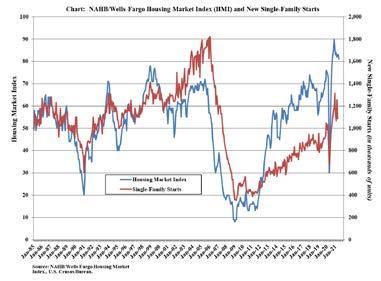
By most metrics it continues to be bullish, though some individual months here-and-there experience weakening in various sectors the trend remains higher. As the home purchasing and rental situation has become so dire, individuals are trying to build their own or prepare to do so, and the demand for rural lots has skyrocketed (perhaps a topic for a later report).
This current crisis is unlike that of 2008, and has much diferent drivers. It would be imprudent to forecast a “crash” or even a large correction at this point. The pandemic remains dominant of the news cycle and exerts a major infuence on life choices.


Boomers continue to retire at an increased rate. Cashfush investment groups with additional leveraged debt could continue their forays into home purchasing, fueling the development of perpetual renting communities. In what is probably a “best-case scenario,” there will be a housing defcit for the next six-years, maybe eleven. Further, that assumes that new builds are situated perfectly in the most desirable locations. If remote workers continue to leave Northern, Midwestern, and Western cities for the suburbs and rural areas of the South, it will exacerbate both demand and vacancy imbalances.
The combination of increased population growth, depleted inventory, home construction defcit, low mortgage interest rate environment, expansion of remote work, and surging Baby Boomer retirements points to continued strength in the Florida, and especially the I-4 corridor’s real estate market for the foreseeable future. Overall, the US real estate market is itself on a very wild ride.
Stay tuned!


